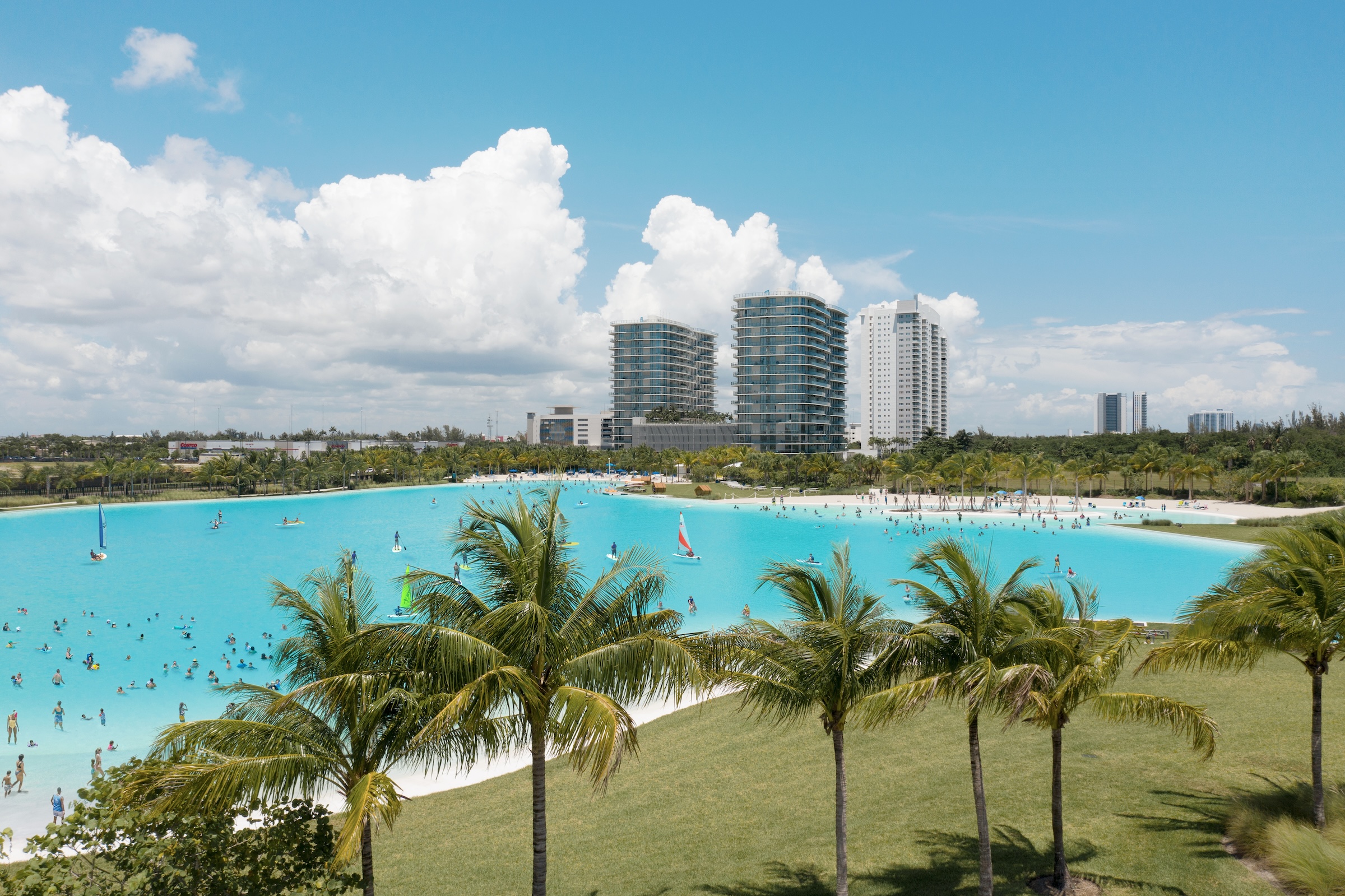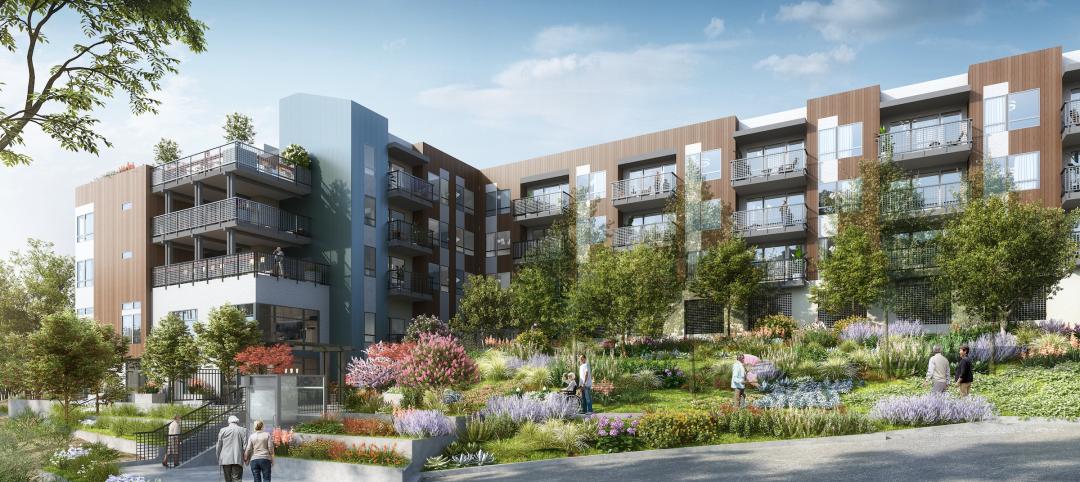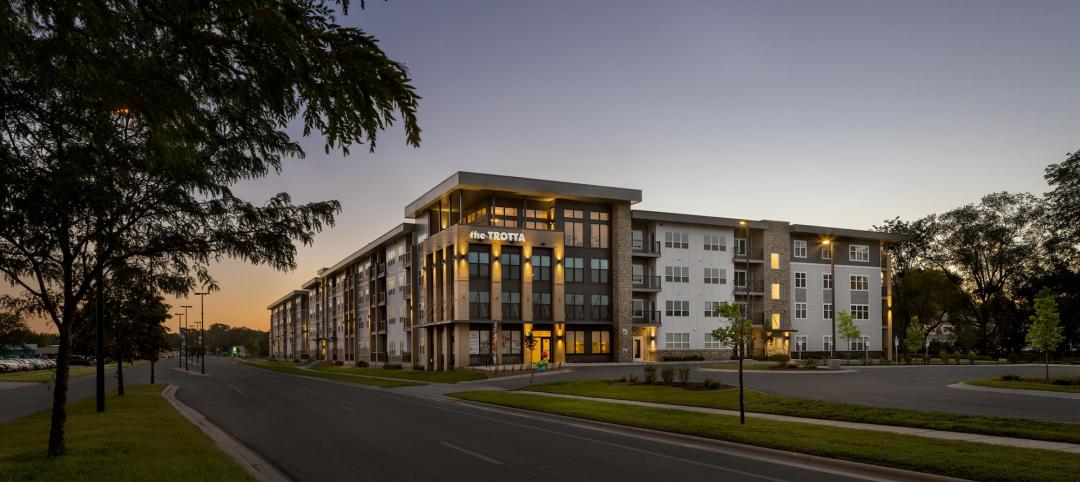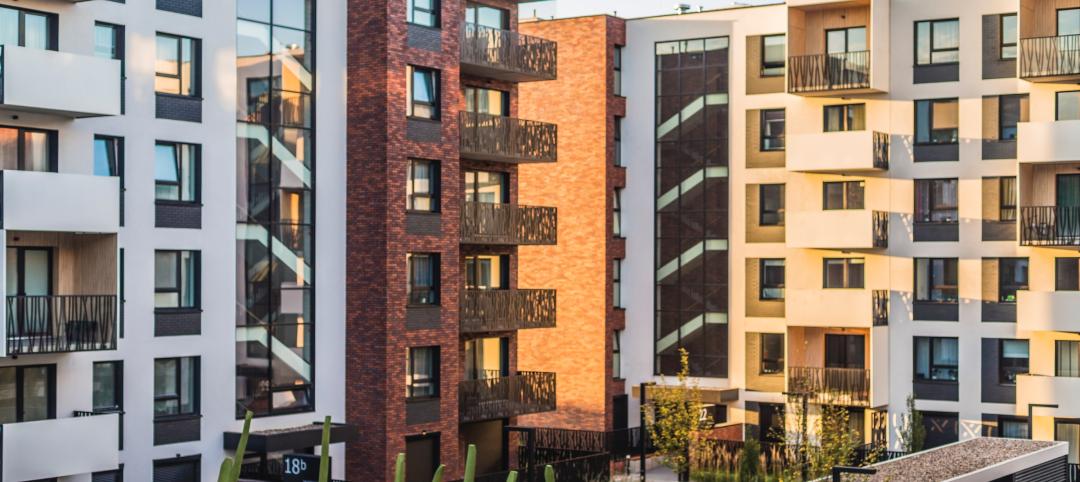“Water features” such as fountains ranked fourth for top-10 quality of life amenities in BD+C’s 2023 Multifamily Amenities report. “Outdoor pools” ranked third for top outdoor amenities (77%), and both indoor and outdoor jacuzzis were among the list of features that residents look for. Clearly, access to water is a must-have for a majority of people.
But what if there was an aquatic amenity guaranteed to turn heads? More novel than a pool, more experience-rich than a fountain, one that stands the seasons to provide a beachfront haven. One company promises just that: year-round, man-made crystal clear blue lagoons.
Crystal Lagoons was founded in 2009 by Fernando Fischmann, a Chilean biochemist and businessman, after searching for a way to make feasible, manmade crystalline lagoons. Throughout years of research, Fischmann faced adversity from technology companies saying the features he sought would never exist. So instead, he took matters into his own hands and invented the technology he dreamed of after several years of independent research and experimentation.
The company has since become a global phenomenon, promoting its aquatic amenity with sustainable maintenance and limitless acreage. A world-class technology that stands as 2019’s most discussed water feature and the “World’s Top Amenity” (according to Crystal Lagoons). But does the international water services company represent a short but fierce trend in the U.S., or will it ride its wave of success for years to come?
Let’s take a closer look at Crystal Lagoons and see where the 2019 “most discussed” amenity stands five years later.
Crystal Lagoons comes to the U.S. real estate market
In its American debut, Crystal Lagoons began as an elevated addition to single-family master-planned communities. The first project utilizing the technology, Epperson Lagoon in Wesley Chapel, Fla., brands itself as a beachfront living paradise with nearly eight acres of clear blue water. Residents are gifted an inland coastal lifestyle and unlimited lagoon access—for the price of $30–$50 per month. In Prosper, Texas, residents of Windsong Ranch have access to a five-acre, 10-million-gallon lagoon at the heart of their community.
Looking at the company five years later, Crystal Lagoons has branched out into bigger avenues. Mixed-use centers, multifamily complexes, hotels/resorts, and even shopping centers have become homes to several manmade lagoons. Crystal Lagoons coins its expansion into these territories as Public Access Lagoons (PAL) projects—a profitable business model that brings beach life to urban environments. This way, the lagoons open up an avenue for multiple revenue streams, from entrance ticket sales to water sports, retail, and day clubs.
One of the largest PAL projects, a mixed-use luxury resort in Orlando, Fla., includes an expansive 20-acre amenity area with beaches surrounding eight acres of water. The resort, Evermore, promotes a vast array of water activities—paddleboarding and kayaking, swimming, watersliding, and cliff jumping—as well as beachfront cabana rentals, picnics, concerts, lounging, and other land uses. What PAL projects like Evermore aim to demonstrate is that surrounding land uses and programming can make the waterfront attractive year-round. Though Crystal Lagoons projects in the U.S. have largely stuck to the Sun Belt states—primarily Florida, Texas, California, and the Carolinas—recent technological innovations allow the lagoons to function year-round. Heated swim zones are a new use of the technology, using Hot Reef technology to warm certain areas of the lagoon for wintertime swimming. Coupled with fire pits and indoor pavilions, chilly climates need not be an obstacle for developers.
This is all made possible through the company’s proprietary technology that allows for disinfection of large bodies of water at a feasible cost. Using a “pulse disinfection” process, each lagoon is treated via controlled pulses of additives in very specific patterns that are determined by Crystal Lagoons’ algorithms. This is monitored and determined electronically by injectors and sensors placed throughout the lagoon. According to Crystal Lagoons, the most important advantages of its technology are its low maintenance and construction costs.
What much do Crystal Lagoons cost to build?
What exactly is the cost of a lagoon? Lisa Moore, former Regional Director of Crystal Lagoons, explained to the Dallas Business Journal: “They’re not cheap.”
“They cost $1 million or $1.5 million an acre, I believe,” Moore said in the 2019 interview—though the figure stands at around $2 million today. “They do have costs to run them, but it’s not quite as expensive as you might think.”
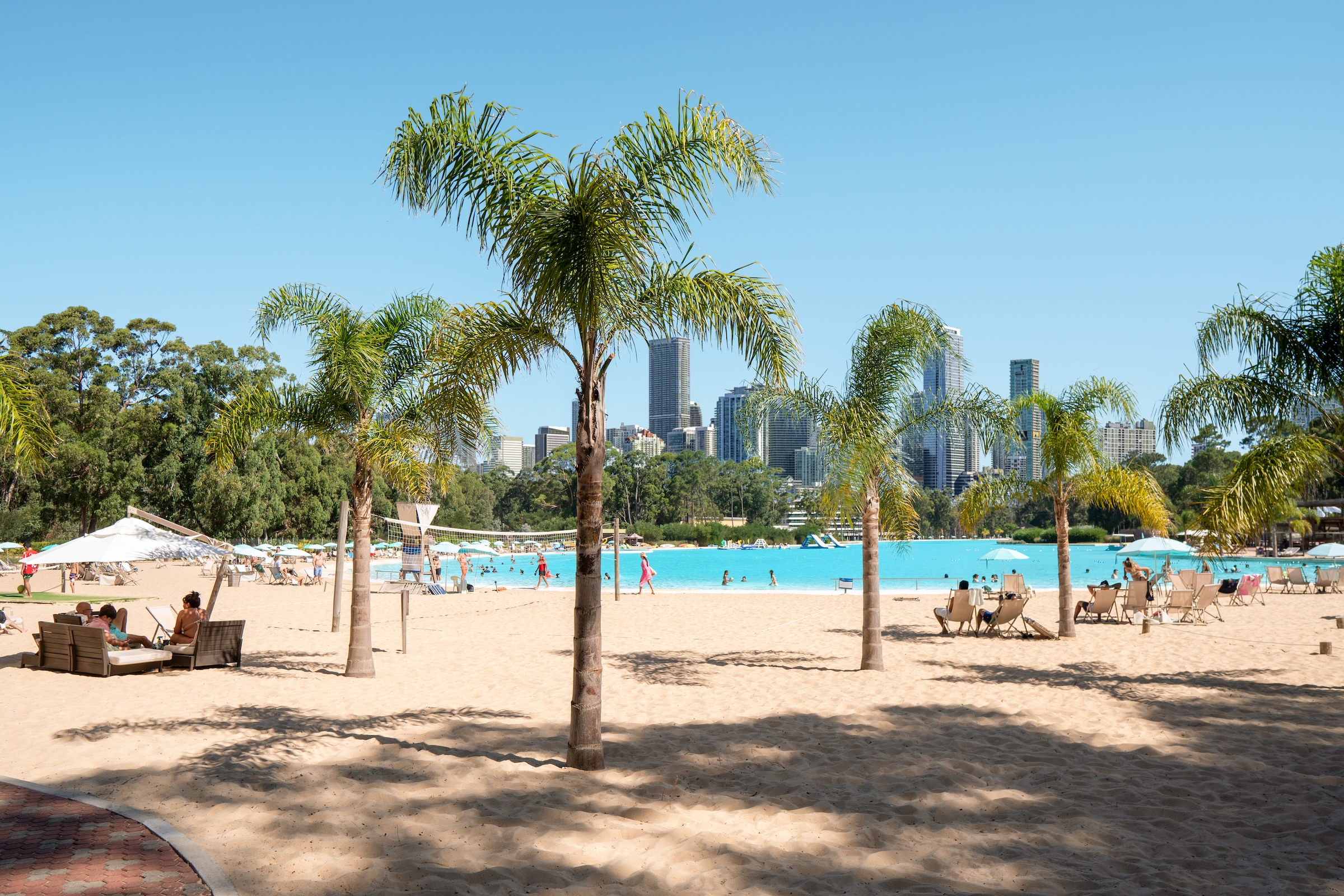
Moore referenced the prices and fees for lagoons at master-planned communities, stating that homeowner’s association dues in a Crystal Lagoons community were around $50 higher per month than one without. Where low costs come in, however, are the maintenance of the lagoons themselves. According to Crystal Lagoons, the pulse disinfection process is less expensive than traditional methods, such as chlorine treatment, and uses up to 100 times less chemicals than conventional swimming pools. What makes this economically feasible—the important aspect for Fernando Fischmann—is the proprietary technology that disinfects unlimited volumes of water. Crystal Lagoons touts its sustainability measures, ensuring that its filtration system uses only 2% of the energy that traditional pool systems use. This is all monitored, controlled, and operated remotely via a 24/7 control center.
Specially designed systems and sensors incorporated in each lagoon continually report the water quality parameters to this control center through a proprietary telemetry platform. This ensures that the water quality of each lagoon complies with international sanitary standards, guaranteeing “optimal quality and transparency,” says Iván Manzur, Senior Vice President of Sales, Crystal Lagoons.
In the end, the technology, filtration, energy savings, is all moot if the water feature doesn’t overcome its biggest hurdle first: regulation.
Crystal Lagoon approval and regulation obstacles
Despite having over 275 Crystal Lagoons projects in various stages around the United States, the hardest battle for each is passing local regulations. In states without prior codes defining Crystal Lagoons (so, most of them), designers need to navigate local regulators’ processes. Firms like Kimley-Horn, who have had its hand in many major lagoons projects, have gone through the approval process in several ways. The first lagoons in Florida were reviewed as a “public bathing place,” since the regulations did not yet define artificial lagoons. Florida and Texas have since adopted some artificial swimming lagoons in their code, but getting regulators to understand the design and implementation of Crystal Lagoons can take months.
“Regulators’ concerns cover the size of the beaches, bathymetry, swim zone sizes and designations, the sizing and quantity of sanitary facilities, water quality testing, signage, and more,” says Chris Falce, PE, LEED AP, CPESC, Vice President, Kimley-Horn. Falce has had an involvement with Crystal Lagoons since the company first made its foray into the states in 2017. In his experience, the success of a project relies on leading regulators through the ins-and-outs of Crystal Lagoons’ technology.
Permitting Timeframes
Falce finds that Florida and California have longer permitting timeframes in general, and in some instances they’ve had to change the design of the lagoon to be approved. Though Crystal Lagoons has made headway in Texas and Florida, Kimley-Horn finds the approval process typically takes 6–12 months.
“The fastest we’ve ever done was in Texas in less than a week,” says Falce. The benefit of pre-application meetings helped regulators understand the lagoon, fast-tracking the entire process. Crystal Lagoons works in coordination with developers to ensure support at each stage of lagoon implementation, facilitating the project's progress. “Every project has challenges to be addressed,” says Manzur, “including regulatory issues, permits, financing, and more—not only in the U.S. but worldwide.”
Crystal Lagoons Design Advice
Because of the possible developments that can be made around a lagoon, “no market is out of the question,” says Falce. This doesn’t mean that Crystal Lagoons are a silver bullet to success, however. To execute a high-level lagoon project, the development itself must be solid, with a knowledgeable design team at the helm of the lagoon.
“You need a team that understands all of the elements required to properly design a cohesive project with the right programming and operational considerations,” says Falce. With the right pieces in place, Falce believes crystalline lagoons can elevate a development and differentiate it from the competition. For AE firms considering the prospect of adding Crystal Lagoons to their portfolio, Falce shares this advice: Anticipate a large learning curve. “You don’t know what you don’t know until you have been through the full design, permitting, and construction process.”
Because the concept is still new in the U.S., Crystal Lagoons projects will likely face headwinds in each new state and jurisdiction they’re introduced to. Kimley-Horn has worked on lagoon projects in California, North and South Carolina, Pennsylvania, Georgia, Nevada, Alabama, Mississippi, Louisiana, Oklahoma, and Arizona—each to varying levels of completion. Today, the water feature is in high demand, with over 275 projects in various stages around the U.S. and a total of 1,000 projects at different stages of development worldwide. The technology aims to not only improve the lives of people, but the planet itself. Crystal Lagoons has started delving into industrial sectors, utilizing the technology to provide continuity to pump storage systems, purify sea- and rainwater, and cool data centers more efficiently than traditional air conditioning.
In 2024, we can expect to see the company dive into deeper waters to expand its portfolio, both in its lagoon projects and industrial use-cases. AE firms interested in seeing where Crystal Lagoons might take them should heed Chris Falce’s advice: “Though you’ll face challenges following the details of the technology, there is extreme value to your clients for getting lagoons incorporated in your project.”
More tips from the Crystal Lagoons experts:
- Anticipate a large learning curve.
- Assemble a design team that understands the technology and end-users.
- Develop a schematic design, capital, and operational budget during due diligence.
- Work with regulators through pre-applications meetings in advance and to help them understand the Crystal Lagoons’ systems.
- Know, understand, and incorporate operations in your design.
- Develop a realistic schedule that considers feasibility, design, permitting, construction, and operations onboarding.
- Qualify and select the right general contractor and operator.
Related Stories
MFPRO+ Research | Mar 6, 2024
Top 10 trends in senior living facilities for 2024
The 65-and-over population is growing faster than any other age group. Architects, engineers, and contractors are coming up with creative senior housing solutions to better serve this burgeoning cohort.
MFPRO+ News | Mar 1, 2024
Housing affordability, speed of construction are top of mind for multifamily architecture and construction firms
The 2023 Multifamily Giants get creative to solve the affordability crisis, while helping their developer clients build faster and more economically.
MFPRO+ Research | Feb 28, 2024
New download: BD+C's 2023 Multifamily Amenities report
New research from Building Design+Construction and Multifamily Pro+ highlights the 127 top amenities that developers, property owners, architects, contractors, and builders are providing in today’s apartment, condominium, student housing, and senior living communities.
Giants 400 | Jan 8, 2024
Top 60 Senior Living Facility Construction Firms for 2023
Whiting-Turner, Ryan Companies US, Weis Builders, Suffolk Construction, and W.E. O'Neil Construction top BD+C's ranking of the nation's largest senior living facility general contractors and construction management (CM) firms for 2023, as reported in the 2023 Giants 400 Report.
Giants 400 | Jan 8, 2024
Top 40 Senior Living Facility Engineering Firms for 2023
Kimley-Horn, Olsson, Tetra Tech, EXP, and IMEG head BD+C's ranking of the nation's largest senior living facility engineering and engineering/architecture (EA) firms for 2023, as reported in the 2023 Giants 400 Report.
Giants 400 | Jan 8, 2024
Top 80 Senior Living Facility Architecture Firms for 2023
Perkins Eastman, Hord Coplan Macht, Lantz-Boggio Architects, Ryan Companies US, and Moseley Architects top BD+C's ranking of the nation's largest senior living facility architecture and architecture engineering (AE) firms for 2023, as reported in the 2023 Giants 400 Report.
MFPRO+ Special Reports | Jan 4, 2024
Top 10 trends in multifamily rental housing
Demographic and economic shifts, along with work and lifestyle changes, have made apartment living preferable for a wider range of buyers and renters. These top 10 trends in multifamily housing come from BD+C's 2023 Multifamily Annual Report.
Giants 400 | Dec 20, 2023
Top 100 Apartment and Condominium Construction Firms for 2023
Clark Group, Suffolk Construction, Summit Contracting Group, and McShane Companies top BD+C's ranking of the nation's largest apartment building and condominium general contractors and construction management (CM) firms for 2023, as reported in Building Design+Construction's 2023 Giants 400 Report.
Giants 400 | Dec 20, 2023
Top 70 Apartment and Condominium Engineering Firms for 2023
Kimley-Horn, WSP, Tetra Tech, and Thornton Tomasetti head BD+C's ranking of the nation's largest apartment building and condominium engineering and engineering/architecture (EA) firms for 2023, as reported in Building Design+Construction's 2023 Giants 400 Report.
Giants 400 | Dec 20, 2023
Top 160 Apartment and Condominium Architecture Firms for 2023
Gensler, Humphreys and Partners, Solomon Cordwell Buenz, and AO top BD+C's ranking of the nation's largest apartment building and condominium architecture and architecture/engineering (AE) firms for 2023, as reported in Building Design+Construction's 2023 Giants 400 Report.



